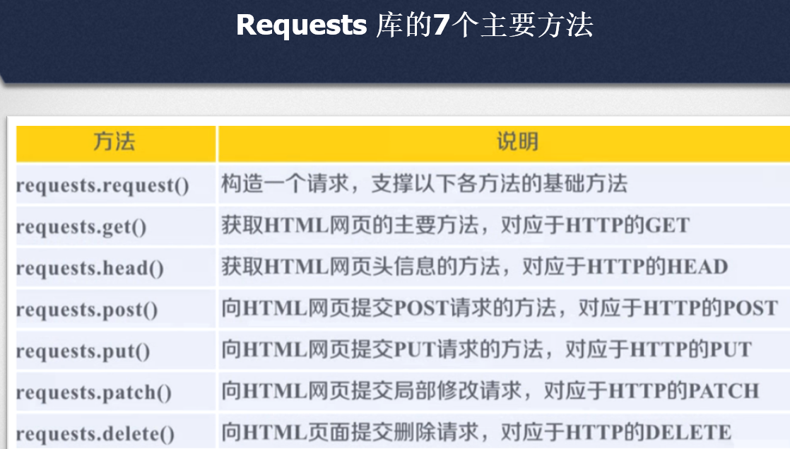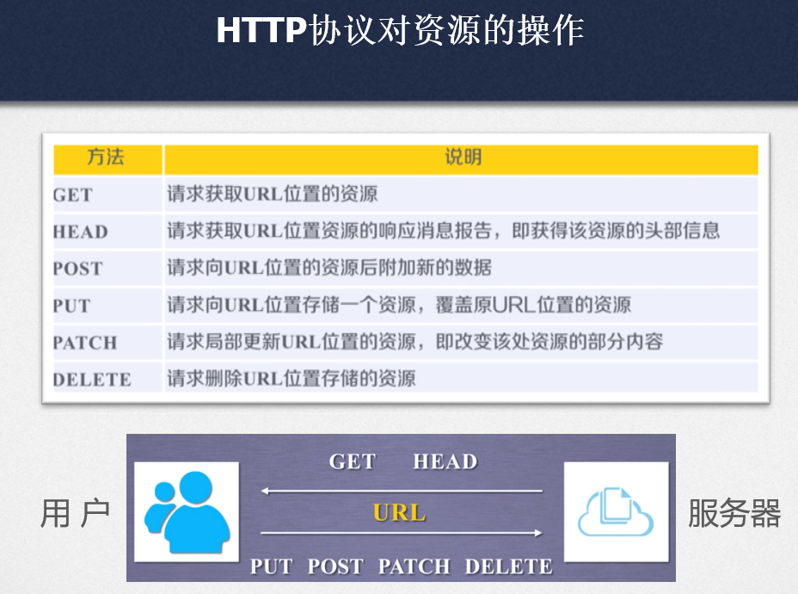title: 爬虫入门一 基础知识 以及request
date: 2020-03-05 14:43:00
categories: python
tags: crawler
爬虫整体概述,基础知识。
requests库的学习
1.request
Requests 是用Python语言编写,基于 urllib,采用 Apache2 Licensed 开源协议的 HTTP 库
http://docs.python-requests.org/en/latest/
1.1
import requests
r=requests.get("http://www.whu.edu.cn/ ") #返回reponse对象
print(r.status_code)
返回值为200时,表明运行正常
输入:r.text 得到网页内容
HTTP状态码
200 成功/正常
404
503
…
1.2 http header
https://www.jianshu.com/p/6f29fcf1a6b3
HTTP(HyperTextTransferProtocol)即超文本传输协议,目前网页传输的的通用协议。HTTP协议采用了请求/响应模型,浏览器或其他客户端发出请求,服务器给与响应。就整个网络资源传输而言,包括message-header和message-body两部分。
根据维基百科对http header内容的组织形式,大体分为Request和Response两部分。
Header中有charset (字符集,也就是编码方式)
r.encoding是从HTTP header中猜测的响应内容编码方式,如果header中不存在charset,则认为编码为‘ISO-8859-1’(无法解析中文字符)
r.apparent_encoding是requests根据网页内容分析出来的
输入“r.encoding ” 查看该网页编码方式为'ISO-8859-1‘
输入“r.apparent_encoding”查看网页编码为'utf-8‘
输入“r.encoding=r.apparent_encoding”
再输入“r.text”,可以发现网页内容变为可以看懂的字符
1.3 异常
遇到网络问题(如:DNS查询失败、拒绝连接等)时,Requests会抛出一个ConnectionError 异常。
遇到罕见的无效HTTP响应时,Requests则会抛出一个 HTTPError 异常。
若请求超时,则抛出一个 Timeout 异常。
若请求超过了设定的最大重定向次数,则会抛出一个 TooManyRedirects 异常。
所有Requests抛出的异常都继承自 requests.exceptions.RequestException 。
1.4 通用框架
注意
Try
Exception
R.raise_for_status()
def getHTMLText(url):
try:
r=requests.get(url,timeout=30)
r.raise_for_status() # 如果状态不是200,引发error异常
# print("%d
%s" % (r.status_code, r.text))
print("%s %s" % (r.encoding, r.apparent_encoding))
r.encoding=r.apparent_encoding
print("%s %s" % (r.encoding, r.apparent_encoding))
#html = r.content # bytes 类型
#html_doc = str(html, 'utf-8') # html_doc=html.decode("utf-8","ignore")
#print(html_doc)
return r.text
except:
return "产生异常"
1.5 requests的方法 //http的操作
注意method的function的区别


def getHTMLText(url):
try:
r=requests.get(url,timeout=30) #reponse 参数 timeout
r.raise_for_status() # 如果状态不是200,引发error异常
# print("%d
%s" % (r.status_code, r.text))
print("%s %s" % (r.encoding, r.apparent_encoding))
r.encoding=r.apparent_encoding
print("%s %s" % (r.encoding, r.apparent_encoding))
#html = r.content # bytes 类型
#html_doc = str(html, 'utf-8') # html_doc=html.decode("utf-8","ignore")
#print(html_doc)
print(r.text)
return r.text
except:
return "产生异常"
def head(url):
r=requests.head(url)
print(r.headers) # 注意head headers
print(r.text) #空
def post(url): #追加
r=requests.get("http://httpbin.org/post")
print(r.text)
payload = {'name': 'your_name', 'ID': 'your_student number'}
r = requests.post("http://httpbin.org/post", data=payload) #参数 data
print(r.text)
def put(url): #覆盖
r = requests.get("http://httpbin.org/put")
print(r.text)
payload = {'name': 'your_name', 'ID': '123456'}
r = requests.put("http://httpbin.org/put", data=payload)
print(r.text)
1.6 Request 访问控制字段 Requests.request(method,url,**kwargs)
标准格式 Requests.request(method,url,**kwargs)
**kwargs:控制访问的参数,均为可选项,共计13个
params: 字典或字节序列,作为参数增加到url中
data: 字典、字节序列或文件对象,作为Request的内容
JSON: JSON格式的数据,作为Request的内容
headers: 字典,HTTP定制头。可模拟任何浏览器向服务器发起请求
hd={'user-agent':'Chrome/56.0'}
r=requests.request('post','https://www.amazon.com/',headers=hd)
Cookies:字典或CookieJar , Request 中 的 cookie
auth : 元组 ,支持HTTP认证功能
files : 字典类型,传输文件
timeout : 设定超时时间,单位为秒
proxles : 字典类型 ,设定访问代理服务器,可以增加登录认证
Allowredirects: True/Fa1se,默认为True,重定向开关
stream : True/Fa1se,默认为True,获取内容立即下载开关
verify : True/Fa1se,默认为True,认证SSL证书开关
Cert :本地SSL证书路径
1.7 爬虫尺寸
网页:requests
网站:scrapy
全网:搜索引擎
1.8 robots协议
Robots协议(也称为爬虫协议、机器人协议等)的全称是“网络爬虫排除标准”(Robots Exclusion Protocol),网站通过Robots协议告诉搜索引擎哪些页面可以抓取,哪些页面不能抓取。
https://www.jd.com/robots.txt
User-agent: *
Disallow: /?*
Disallow: /pop/*.html
Disallow: /pinpai/*.html?*
User-agent: EtaoSpider
Disallow: /
User-agent: HuihuiSpider
Disallow: /
User-agent: GwdangSpider
Disallow: /
User-agent: WochachaSpider
Disallow: /
*代表所有,/代表根目录
User-agent: *
Disallow: /
下面四种爬虫被京东认为恶意爬虫,拒接其访问
1.9 chrome 查看useragent
F12 network name
2.requests的例子
import requests
import os
def amazon():
#url="https://www.amazon.cn"
# r=requests.get(url)
# print(r.status_code)
#url="https://www.amazon.com"
#理论上python直接爬,可以看到requests请求很诚实的告诉了网站访问使用Python发起的,
# 该网站通过头信息判断该访问是爬虫发起的而不是由浏览器发起的。amazon会503,使用useragent模拟浏览器后没问题
#问题是直接10060.
#url = "https://www.amazon.co.jp"
# try:
# r=requests.get(url)
# #r = requests.get(url,timeout=5)
# print(r.request.headers) #头信息
# #print(r.request.url)
# #r.raise_for_status()
# print(r.status_code)
# except:
# print("except %s"% r.status_code)
# print(r.request.headers) # 注意是request 网站通过头信息判断是python发起,爬虫,拒绝
#hd = {'user-agent': 'Mozilla/5.0 (Windows NT 10.0; Win64; x64) AppleWebKit/537.36 (KHTML, like Gecko) Chrome/80.0.3987.122 Safari/537.36'}
#r = requests.request('post', url=url, headers=hd)
#r = requests.get(url, headers=hd)
#print("final %s"% r.status_code)
#上面是网络问题导致的amazon访问不了,我还以为是代码问题改了很久...下面这样做就行 了
url = "https://www.amazon.com"
r=requests.get(url)
print("%s %s"%(r.status_code,r.request.headers)) #注意是request.headers不是requests
#503 {'User-Agent': 'python-requests/2.21.0', 'Accept-Encoding': 'gzip, deflate', 'Accept': '*/*', 'Connection': 'keep-alive'}
hd = {'user-agent': 'Mozilla/5.0 (Windows NT 10.0; Win64; x64) AppleWebKit/537.36 (KHTML, like Gecko) Chrome/80.0.3987.122 Safari/537.36'}
#r = requests.request('post', url=url, headers=hd) #请求方式是post,返回状态码405,后台不允许post
r = requests.get(url, headers=hd)
print("%s %s" % (r.status_code, r.request.headers)) #200
def searchengine():
keyword = "知乎"
try:
kv = {'wd': keyword}
r = requests.get("http://www.baidu.com/s", params=kv)
print(r.request.url)
r.raise_for_status()
print(r.text[1:1000])
# 结果太长,打印前1000个字符
except:
print("爬取失败")
# 百度直接搜索 武汉大学,华科
# https: // www.baidu.com / s?wd = 武汉大学 & rsv_spt = 1……
# https: // www.baidu.com / s?wd = 华中科技大学 & rsv_spt = 1……
# 所以只需要替换wd即可搜索
#
def images():
#可以通过循环语句,批量爬取大量图片 正则式也可
url = "https://meowdancing.com/images/timg.jpg"
root = "F://Pictures//"
path = root + url.split('/')[-1] #split 通过 / 分片,取最后一片也就是timg.jpg
try:
if not os.path.exists(root):
os.mkdir(root) # 用于以数字权限模式创建目录
if not os.path.exists(path):
r = requests.get(url)
with open(path, 'wb')as f:
f.write(r.content)
f.close()
print("文件保存成功")
else: # 写代码时注意缩进
print("文件已存在")
except:
print("爬取失败")
def ipaddress():
url = "http://www.ip138.com/ips138.asp?ip="
ip="101.24.190.228"
url=url+ip
# +"&action=2" 不加也可以
hd = {
'user-agent': 'Mozilla/5.0 (Windows NT 10.0; Win64; x64) AppleWebKit/537.36 (KHTML, like Gecko) Chrome/80.0.3987.122 Safari/537.36'}
print(url)
try:
r = requests.get(url,headers=hd) #不加hd好像不行
print(r.status_code)
r.raise_for_status()
r.encoding = r.apparent_encoding
print(r.text[-2000:]) # 输出最后2000个字符
except:
print("爬取失败")
# 打开
# http: // www.ip138.com / 可以通过输入IP地址查询地理位置,输入IP地址后,查看浏览器链接
# http: // www.ip138.com / ips138.asp?ip = 202.114
# .66
# .96 & action = 2
# 可以看出,查询链接为
# http: // www.ip138.com / ips138.asp?ip =“你的IP地址”
#
# 通过这个例子我们可以看出,很多人机交互的操作,实际上是通过提交的HTTP链接来完成的,
# 因此当我门通过简单的分析,得知HTTP链接与交互信息的对应关系后,就可以通过Python,爬取我们所需的资源
if __name__ == "__main__":
#amazon()
#searchengine()
#images()
ipaddress()